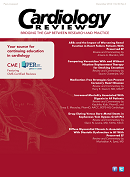Increased Mortality Associated with Digoxin in AF Patients
Although digoxin has a very long clinical history, no randomized controlled trial has evaluated the use of digoxin for atrial fibrillation (AF). Therefore, the evidence for its use in AF is based on post hoc analyses of RCTs or on findings from observational studies. Several studies have shown the association of digoxin use with increased mortality rates. However, other studies have reported the opposite conclusions, and it remains controversial whether digoxin use is associated with increased mortality in patients with AF.

Kazuhiko Kido, PharmD
and Tracy E. Macaulay, PharmD, AACC, BCPS-AQ Cardiology
Review
Turakhia MP, Santangeli P, Winkelmayer WC, et al. Increased mortality associated with digoxin in contemporary patients with atrial fibrillation. Findings from the TREAT-AF Study. J Am Coll Cardiol. 2014;64:660-668.
Although digoxin has a very long clinical history, no randomized controlled trial (RCT) has evaluated the use of digoxin for atrial fibrillation (AF). Therefore, the evidence for its use in AF is based on post hoc analyses of RCTs or on findings from observational studies. Several studies have shown the association of digoxin use with increased mortality rates.1,2 However, other studies have reported the opposite conclusions,3,4 and it remains controversial whether digoxin use is associated with increased mortality in patients with AF.
Study Details
Turakhia and colleagues recently published a report in the Journal of the American College of Cardiology of their evaluation of digoxin use in patients with newly diagnosed, nonvalvular AF and its association with mortality.5 The Retrospective Evaluation and Assessment of Therapies in AF (TREAT-AF), was a retrospective cohort study from the Veterans Affairs (VA) health care system outpatient database between VA fiscal years 2004 and 2008. Key inclusion criteria were a primary or secondary diagnosis of AF by ICD-9 codes 427.31 or 427.32 in a VA inpatient or outpatient encounter, a second confirmatory diagnosis 30 to 365 days after the initial diagnosis, and an outpatient follow-up visit in the clinic 90 days after the initial diagnosis.
Main exclusion criteria included prior AF diagnosis, history of valve diseases, thyroid disease, kidney transplant, or cardiac surgery within the previous 30 days. The primary outcome was time to death, beginning from 90 days after index AF diagnosis. Cox multivariate regression analysis was performed to adjust for the effect of variables in both the full study population and in a propensity-matched cohort.
The full study cohort included 122,465 patients from the VA health care system centralized data sets. The mean age of the patients was 72.1 years, 1.6% were women, and 36.8% had impaired renal function (estimated glomerular filtration rate <60 mL/min/1.73 m2 or on dialysis). Baseline characteristics between digoxin recipients and non-recipients were similar in age and race, but the percentage of patients with heart failure (HF) or who used beta-blockers, angiotensin receptor blockers, antiplatelet therapy, diuretics, and warfarin was significantly higher in the digoxin recipient group. Of note, ejection fraction was not included in the evaluation. The propensity-matched cohort demonstrated comparable baseline characteristics between digoxin recipients and nonrecipient groups (n = 26,703 in each group), with no statistically significant differences in characteristics.
Digoxin use was associated with an increased mortality rate in the unadjusted full cohort ( HR, 1.37; 95% CI, 1.33-1.40; P <.001). The association persisted but the degree of this association was attenuated in multivariate Cox regression analysis (HR, 1.26; 95% CI, 1.23-1.29; P <.001) and after propensity matching (HR, 1.21; 95% CI, 1.17-1.25; P <.001). The association was consistent across subgroups based on drug adherence, clinical comorbidities, concomitant therapy, and kidney function. The risk may be increased in patients with prior myocardial infarction (MI) based on subgroup analysis in both the full cohort (HR, 1.49; 95% CI, 1.34-1.67; P value for interaction, .002) and the propensity-matched cohort (HR, 1.45; 95% CI, 1.26-1.66; P value for interaction, .077).
CommentaryA study with many strengths
Currently, few other studies have evaluated the effect of digoxin use on mortality rate in AF. One of the published prospective studies is the Stockholm cohort study, with 2824 patients followed for approximately 4.6 years prospectively.2 Propensity score matching and Cox multivariate regression analysis were utilized. Investigators found that digoxin use was associated with increased mortality (HR, 1.94; 95% CI, 1.71-2.20; P <.001), but the association was no longer observed after adjusting for baseline differences (HR, 1.05; 95% CI, 0.92-1.20).
Two post-hoc analyzes of the Atrial Fibrillation Follow-up Investigation of Rhythm Management (AFFIRM) trial have evaluated the relationship between digoxin therapy and mortality in patients with AF, with different outcomes.3,4 The first group assessed the association between digoxin and mortality using multivariate Cox proportional hazards models.3 They found that digoxin was associated with the increased all-cause mortality rate (HR, 1.35; 95% CI, 1.06-1.71; P = .016). Remarkably, it also showed that there was no significant digoxin-gender interaction for all-cause mortality, and interactions existed regardless of HF status. The second group employed a different trial design to the same AFFIRM cohort, using propensity score matching, and found no negative association between digoxin use and mortality (HR, 1.06; 95% CI, 0.83-1.37; P = .64).4 Conflicting findings in these evaluations still offer little resolution to the safety of digoxin use in patients with AF.
This large retrospective cohort study has remarkable strengths. First, the database-based cohort study included the largest AF cohort, which allows this study to conduct more robust subgroup analysis based on age, drug adherence, kidney function, past medical histories of MI or HF, or concomitant therapy with warfarin, beta-blockers, and amiodarone, without any concern for type 2 error. Also, multivariate logistic analysis was conducted in the propensity-matched cohort because of the large sample size. Second, the VA database in the TREAT-AF trial may be more representative of current US practice than the other data sources were, and may be more applicable to current medicine practice. For example, the AFFIRM trial6 was published in 2002 and the TREAT-AF trial collected data from 2003 to 2008. The outcomes of earlier studies could have been affected by not being able to use more contemporary treatments for HF, CAD, and stroke prevention, thus resulting in lower external validity.
Several limitations do exist. The most notable is that the TREAT-AF study is not randomized, merely observational. Therefore, findings from this study need to be applied with caution. Also, some other features of this study design limit generalizability. First, this cohort mainly included male veterans, which makes it difficult to apply findings to women. The Digitalis Investigation Group trial showed the effect of sex on mortality in patients with HF, but the relationship between digoxin use and outcomes was more significant in the subgroup of women.7 In addition, the cohort only included newly diagnosed AF patients; the AFFIRM trial population was more elderly, asymptomatic, or marginally symptomatic. More important, this cohort study was not able to include assessments of New York Heart Association functional class or measures of left ventricular ejection fraction, whereas differences in these variables could have affected the results. However, the AFFIRM trial post-hoc study by Whitbeck et al3 showed that digoxin use was associated with a significantly increased mortality in AF patients regardless of the presence or absence of HF.
It remains a matter of controversy whether patients maintained on digoxin should be stopped completely based only on study results from this observational study. However, at the least, the use of digoxin should be strictly evaluated and its initiation selected with care in AF patients. Until further evaluation, digoxin should be reserved for patients who have symptomatic hypotension and/or HF with reduced ejection fraction when other rate-control agents cannot be safely initiated.
References
1. Hallberg P, Lindback J, Lindahl B, et al. Digoxin and mortality in atrial fibrillation: a prospective cohort study. Eur J Clin Pharmacol. 2007;63:959-971.
2. Friberg L, Hammar N, Rosenqvist M. Digoxin in atrial fibrillation: report from the Stockholm cohort study of atrial fibrillation (SCAF). Heart. 2010;96:275-280.
3. Whitbeck MG, Charnigo RJ, Khairy P. et al. Increased mortality among patients taking digoxin—analysis from AFFIRM study. Eur Heart J. 2013;34:1481-1488.
4. Gheorghiade M, Fonarow GC, van Veldhuisen DJ, et al. Lack of evidence of increased mortality among patients with atrial fibrillation taking digoxin: findings from post-hoc propensity-matched analysis of the AFFIRM trial. Eur Heart J. 2013;34:1489-1497.
5. Turakhia MP, Santangeli P, Winkelmayer WC, et al. Increased mortality associated with digoxin in contemporary patients with atrial fibrillation. J Am Coll Cardiol. 2014;64:660-668.
6. Wyse DG, Waldo AL, DiMarco JP, et al. A comparison of rate control and rhythm control in patients with atrial fibrillation. N Engl J Med. 2002;347:1825-1833.
7. The Digitalis Investigation Group. The effect of digoxin on mortality and morbidity in patients with heart failure. N Engl J Med. 1997;336:525-533.
About the Author
Kazuhiko Kido, PharmD, is a PGY2 cardiology pharmacy resident at the University of Kentucky HealthCare, Lexington, Kentucky. He was assisted in the writing of this article by Tracy E. Macaulay, PharmD, AACC, BCPS-AQ Cardiology, clinical pharmacy specialist-cardiology, PGY2 residency program director-cardiology, and adjunct assistant professor at University of Kentucky HealthCare in the Department of Pharmacy Services and Division of Cardiovascular Medicine, Lexington, Kentucky.
